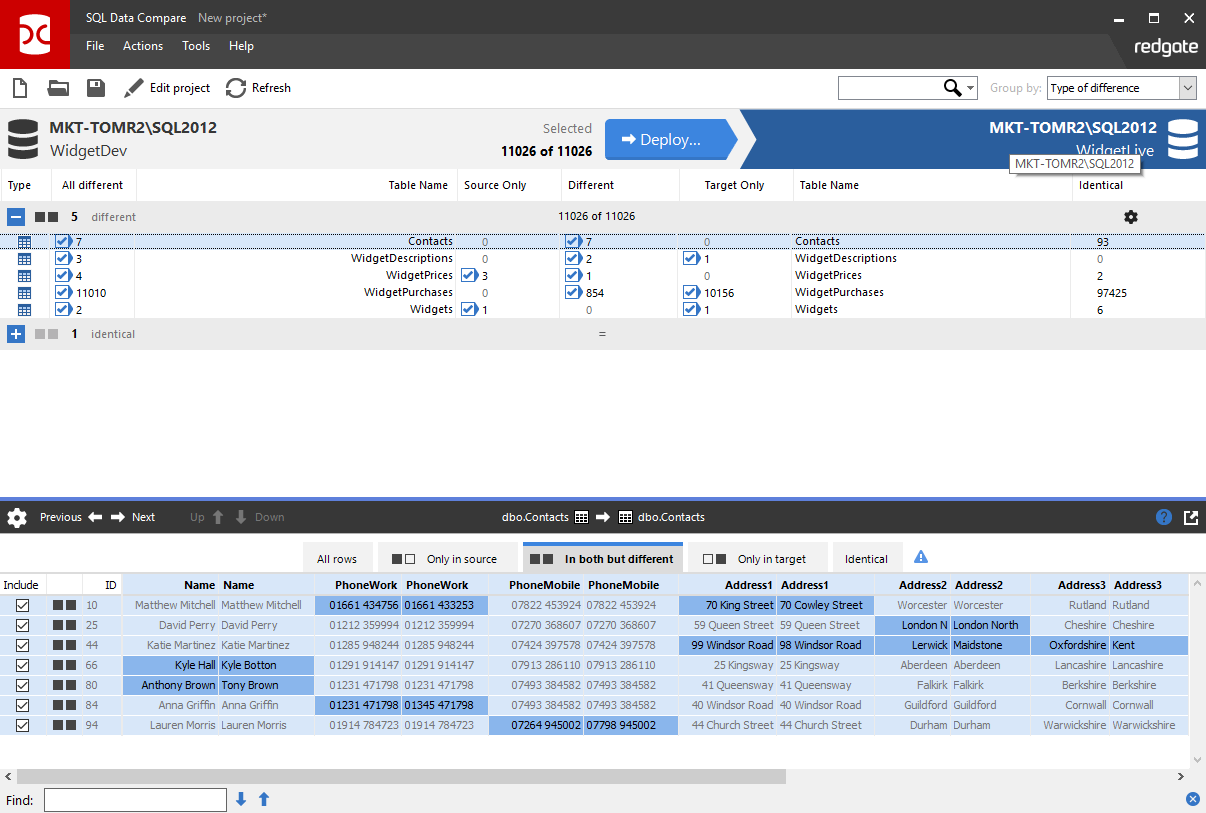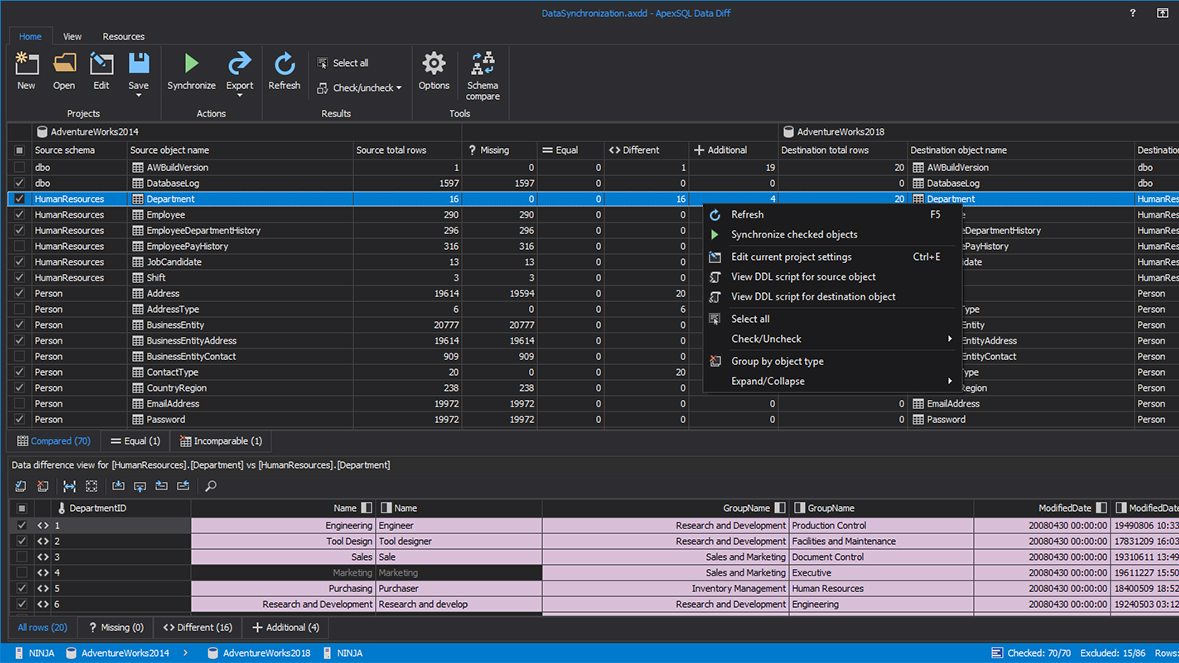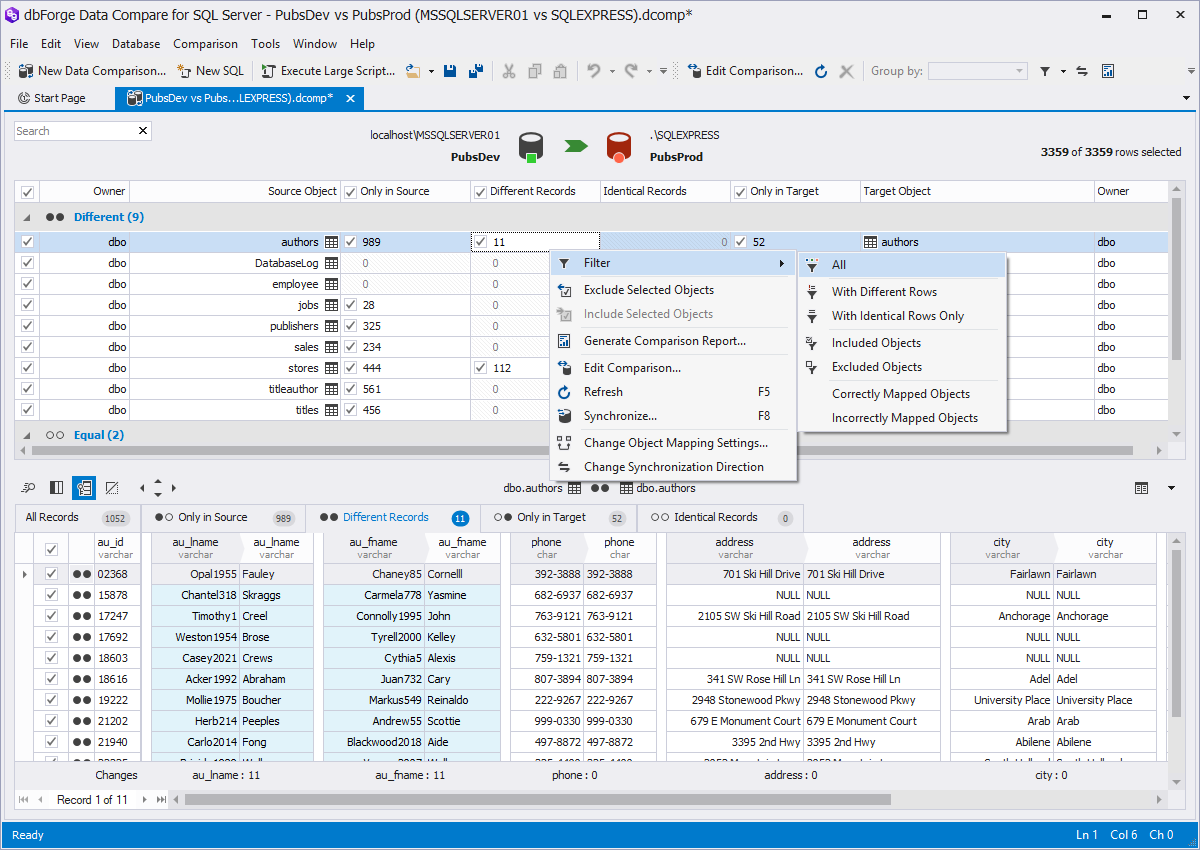![]()
Certainly! Here’s a comprehensive overview of SQL Server Data Compare Tools, detailing their features, functionalities, and step-by-step usage.
Introduction to SQL Server Data Compare Tools
SQL Server Data Compare Tools are specialized utilities designed to compare and synchronize the data between two SQL Server databases. These tools are essential for database administrators and developers when migrating data, performing upgrades, or ensuring consistency between environments.
Key Features of SQL Server Data Compare Tools
- Data Comparison: Identify differences in data between two databases, including tables and views. (Compare and Synchronize the Data of Two Databases – SQL Server …)
- Data Synchronization: Generate scripts to synchronize data from one database to another. (Compare and Synchronize the Data of Two Databases – SQL Server …)
- Selective Synchronization: Choose specific tables or rows to synchronize, offering granular control.
- Automation Support: Integrate with CI/CD pipelines for automated data synchronization.
- Backup and Restore: Compare data from live databases, backups, or SQL scripts. (Compare and deploy SQL Server database contents)
- Cross-Platform Support: Some tools support data comparison between on-premises SQL Server and Azure SQL Database.
Popular SQL Server Data Compare Tools
1. Redgate SQL Data Compare
Redgate SQL Data Compare is a widely used tool known for its reliability and ease of use.
- Features:
- Compare and synchronize SQL Server database contents.
- Work with live databases, backups, or SQL scripts.
- Restore damaged or missing data to a single row without full database recovery. (Diff and Synchronize SQL Server Database Contents – YouTube, Compare and deploy SQL Server database contents)
- Website: (Compare and deploy SQL Server database contents)
2. dbForge Data Compare for SQL Server
dbForge Data Compare offers a comprehensive solution with advanced features.
- Features:
- Compare tables, views, backups, and custom queries.
- Filter and sort objects in results.
- Perform full-text data search.
- View the number of changes per column.
- Hide unmodified columns to simplify analysis.
- Select arbitrary columns for display. (dbForge Data Compare for SQL Server – Features – Devart, dbForge Data Compare for SQL Server – Devart)
- Website: (dbForge Data Compare for SQL Server – Devart)
3. ApexSQL Data Diff
ApexSQL Data Diff is known for its detailed reporting and scheduling capabilities.
- Features:
- Compare and synchronize data between SQL Server databases.
- Generate detailed reports of data differences.
- Schedule data synchronization tasks.
- Automate data comparison processes. (Compare And Synchronize SQL Server Schemas – Redgate Software)
- Website: (22 Best Data compare tools for SQL Server for 2025 – DBMS Tools)
4. SQL Data Compare by Redgate
SQL Data Compare by Redgate is a robust tool for comparing and deploying SQL Server database contents. (Compare and deploy SQL Server database contents)
- Features:
- Compare and deploy changes quickly and accurately.
- Work with live databases, backups, or SQL scripts.
- Restore damaged or missing data to a single row.
- Automate comparisons and deployments. (Red Gate SQL Data Compare – DBMS Tools, Compare and deploy SQL Server database contents, Compare And Synchronize SQL Server Schemas – Redgate Software)
- Website: (Compare and deploy SQL Server database contents)
Step-by-Step Guide to Using SQL Server Data Compare Tools
Step 1: Install the Data Compare Tool
- Download: Obtain the installer from the official website of the chosen tool.
- Installation: Run the installer and follow the on-screen instructions to complete the installation process.
Step 2: Launch the Application
- Open: After installation, launch the application from the Start menu or desktop shortcut.
Step 3: Connect to Source and Target Databases
- Source Database: Provide connection details for the source database.
- Target Database: Provide connection details for the target database.
Step 4: Select Objects for Comparison
- Choose Objects: Select the tables or views you wish to compare between the source and target databases.
Step 5: Perform Data Comparison
- Run Comparison: Initiate the comparison process to identify differences between the selected objects.
- Review Results: Examine the results to understand the discrepancies between the databases.
Step 6: Synchronize Data
- Generate Script: Create a script to synchronize the target database with the source database.
- Execute Script: Run the generated script to apply the changes to the target database. (Compare and Synchronize the Data of Two Databases – SQL Server …)
Step 7: Verify Synchronization
- Check Data: Verify that the data in the target database matches the source database after synchronization. (Compare and Synchronize the Data of Two Databases – SQL Server …)
Best Practices for Using Data Compare Tools
- Backup Databases: Always back up both source and target databases before performing any synchronization.
- Test in Development Environment: Perform comparisons and synchronizations in a development environment before applying changes to production databases.
- Review Generated Scripts: Carefully review the scripts generated by the tool to ensure they will perform the desired actions.
- Schedule Regular Comparisons: Implement regular data comparisons to monitor and maintain data consistency. (SQL data compare tool | ApexSQL)
- Use Automation: Leverage automation features to streamline the comparison and synchronization processes. (Comparing Two Databases: Tools, Techniques, and Detailed …)
SQL Server Data Compare Tools are invaluable for maintaining data consistency across different environments. By selecting the appropriate tool and following best practices, database administrators and developers can efficiently manage and synchronize data between SQL Server databases.
For a visual demonstration of comparing two SQL Server databases, you may find the following video helpful:
(How To Compare Two SQL Server Databases)




